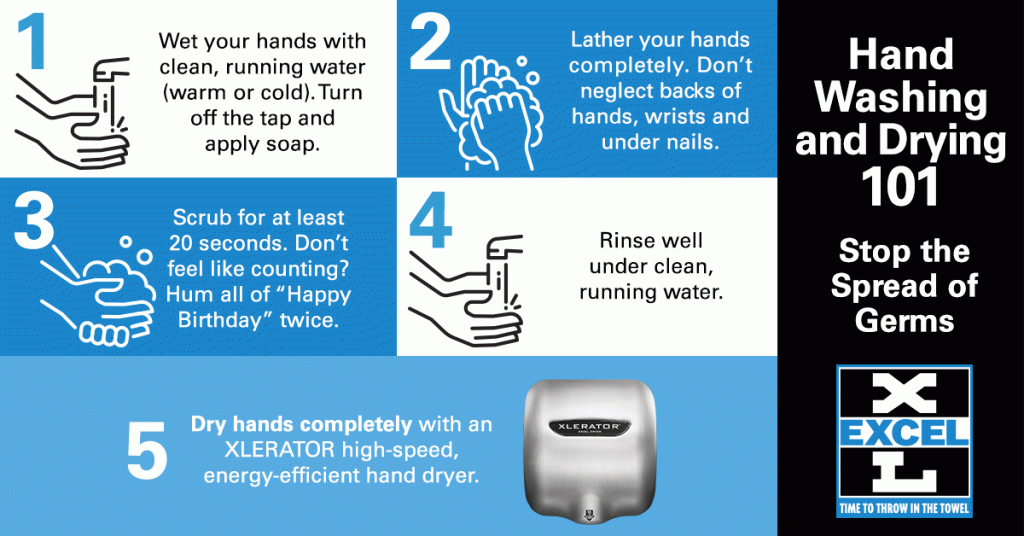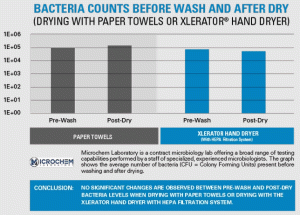Winter Health is in Your Hands (A Handy Guide)
All the experts agree: proper handwashing and drying play an essential role in preventing the spread of germ-borne illness. According to the Centers for Disease Control (CDC), proper handwashing and drying can prevent about 30% of diarrhea-related sicknesses like norovirus and about 20% of respiratory infections like colds and flu. That is a significant reduction, placing hand hygiene at the top of the list of preventive measures we should all take, especially during the colder months. Literally speaking, winter health is in your hands!
As the scientific community learned more about the spread of COVID-19, it became evident that it was primarily an airborne virus. That doesn’t mean hand hygiene doesn’t remove COVID virus from the hands, but the virus is far less likely to spread from contact with hands and surfaces than from inhalation of airborne droplets. Based on current data, vaccination is your top defense against COVID-19. A well-fitted N95 mask will further aid in protection.
It’s the more traditional viral villains of the winter months—cold, flu, norovirus—that can easily spread via transmission from hands to mouth and nose, thanks to contact with contaminated surfaces. In the colder months, we’re most likely to be sharing indoor spaces with lots of people, some of whom could carry viruses without even knowing it. These unknowing carriers may deposit the germs on surfaces like doorknobs, countertops, bathroom surfaces, keypads and public transportation seats and handrails. Regular handwashing, combined with vigilance against touching our faces, helps significantly reduce this surface transmission.
Not “Common Sense”—Most of Us Get Handwashing Wrong!
 In effective handwashing, the method matters, and unfortunately, most of us don’t take the time to do it right. In fact, one study estimated that 95 percent of Americans don’t follow basic protocol, robbing themselves of handwashing’s preventive benefits!
In effective handwashing, the method matters, and unfortunately, most of us don’t take the time to do it right. In fact, one study estimated that 95 percent of Americans don’t follow basic protocol, robbing themselves of handwashing’s preventive benefits!
Here’s the method recommended by the CDC for effectively washing and drying hands:
- Wet your hands with clean, running water (warm or cold), turn off the tap and apply soap.
- Lather your hands by rubbing them together with the soap. Lather the backs of your hands, between your fingers and under your nails.
- Scrub your hands for at least 20 seconds. Need a timer? Hum the “Happy Birthday” song from beginning to end twice.
- Rinse your hands well under clean, running water.
- Dry your hands using a clean towel or an air dryer.
Hand Dryers and Hygiene: Stick to the Facts and Let Them Tok
Naturally, we can’t over-emphasize the importance of that final step—and with good reason. The CDC emphasizes the role of hand drying in hand hygiene, stating, “Germs spread more easily when hands are wet, so make sure to dry your hands completely, whatever method you use.”
To support this assertion by the CDC, research from the University of Auckland, New Zealand, also found dry hands result in a 99% reduction in the level of bacteria transmission when compared to wet hands. To put this another way, wet hands are 1,000 times more likely to transfer bacteria, so your hands are never fully clean until they are clean and dry.
There’s also been a lot of misinformation blowing around on social media (we’re looking at you, TikTokkers) claiming that hand dryers actually help spread germs. Remember: just because a Tokker goes viral, that doesn’t mean they’re an expert on viruses! Allow us to “clear the air.”
Hundreds of studies have been funded to determine the hygienic benefits of various hand drying methods, but not all studies are created equal. In 2020, University of Arizona researchers published a review of the available material.
“Some of the top-ranking articles in our Google search were white papers authored or sponsored by paper companies,” said Dr. Kelly Reynolds, the Director of the University’s Environment, Exposure Science & Risk Assessment Center. “Additionally, media reports frequently used sensationalized headlines. While such headlines may increase traffic, they sometimes overgeneralize or exaggerate research results. Consumers may only read the headlines which can influence public opinion toward biased or erroneous conclusions.”
| “From a health and safety perspective, we found no empirical data to support one hand-drying method [hand dryers vs. paper towels] over another,” said Dr. Reynolds. |
Dr. Reynolds and her team culled the data, including published studies, news reports and online content, seeking to uncover which hand drying method—hand dryers or paper towels—is more hygienic and safer relative to human infection risks. “From a health and safety perspective, we found no empirical data to support one hand-drying method [hand dryers vs. paper towels] over another,” said Dr. Reynolds.
Electrostatic HEPA: Next-Level Prevention
Hands-under dryers like XLERATOR eliminate the multiple unnecessary touch points that come with using paper towels, and prevent the germ-laden waste those towels would become. Now, our electrostatic HEPA filtration system—PROVEN to remove 99.999% (read: all) of viruses from the airstream—does more than ever to settle the debate about hand dryer hygiene by delivering clean, filtered, purified air fast and efficiently.
 |
This upgraded filter:
- Uses electrostatically charged filter media, which eliminates germs by attracting them to the media and allows for increased airflow
- Is the only one on the market with a metal mesh washable pre-filter for reliable service and extended filter life
- Is available as an optional feature with our XLERATOR and XLERATOReco hand dryers, as well the ADA-compliant ThinAir hand dryer, and can easily be retrofitted into existing units
- Comes as a standard feature on our XLERATORsync Hand Dryer, designed for integration with sink systems by D|13 Group
Adding an antimicrobial Wall Guard with our wall-mounted dryers will contribute significantly to a reduction in viral transmission, adding to the benefit of hand drying.
Further, studies have shown that unused paper towels made from recycled fibers can actually contain germs including influenza and E. coli! And paper towels often create maintenance problems like incorrect disposal or even clogged toilets, potentially increasing the risk of viral transmission.
Handwashing Frequency
Wash thoroughly and often! Washing too infrequently robs handwashing of its full preventive power. During the cold and flu season, it’s advisable to wash hands multiple times an hour, especially if you’re interacting with lots of people. It’s also best to wash your hands after coughing, sneezing, or touching your face, just to help prevent the spread.

- Before, during, and after preparing food
- Before and after eating food
- Before and after caring for someone at home sick with vomiting or diarrhea
- Before and after treating a cut or wound
- After using the toilet
- After changing diapers or cleaning up a child who has used the toilet
- After blowing your nose, coughing, or sneezing
- After touching an animal, animal feed, or animal waste
- After handling pet food or pet treats
- After touching garbage
These are the absolute must-wash situations—but it can’t hurt to err on the side of caution. When in doubt, wash ‘em out!
Winter Health Is in Your Hands
Handwashing is important all year round, but it should be top of mind for us during the cold and flu season. Getting into practice with frequent washing and using the proper method will help reduce our chances of getting sick or spreading illness to others. Winter health is in your hands.
